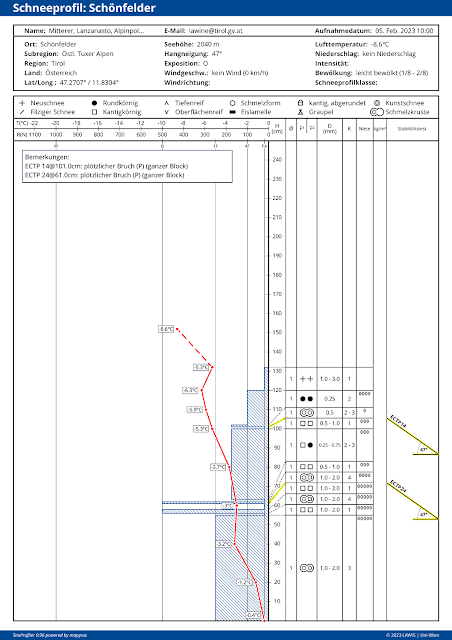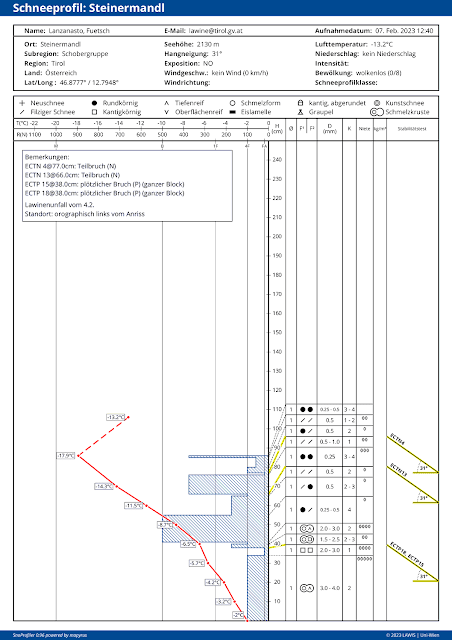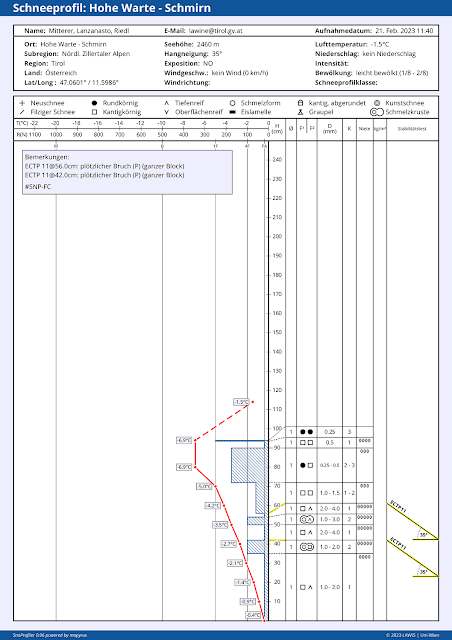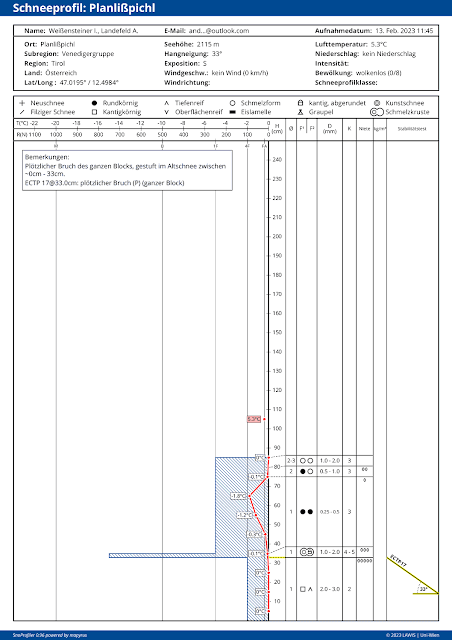Avalanche time
The term “avalanche time” has locked a heavy stamp on the education of Austrian mountain and ski guides. It designates the short period in a winter season which bears far higher risks of avalanches. Just such a period was what we had between 3rd and 6th of February. Within that short time, 8 people died in avalanches. (A comparable avalanche period occurred last winter at the same juncture. Between 4th and 5th of February 2022, also 8 persons were killed in avalanches.)
Persistent weak layer: primal cause
To start off: in all the recent avalanches with fatalities the persistent weak layer was the cause. Snowpack analysis on-site or in the immediate vicinity of the accident brought the selfsame picture: a long-enduring weak layer of faceted crystals (sometimes with depth hoar) was found beneath a thin melt-freeze crust. Atop that, usually a pronounced slab from the previous bout of precipitation including transported snow masses.
64 avalanches were reported to Avalanche Headquarters Tirol between 3 and 5 February
Here is an overview of the avalanches reported to headquarters between 3 and 5 February.
 |
| Reports of avalanches came from all of Tirol (map was extended to include the fatal accident on 6 February in the Wannenkar near the Hohen Wasserfalle) 7 had fatalities, 15 avalanches in which persons were involved, 42 negative avalanches (map: (c) Landeswarnzentrale Tirol) |
Most avalanche investigations made with assistance of state helicopter
Our accident analysis is undertaken with the Alpine Police. The state helicopter assisted us with indispensable service, enabling us to save valuable time during this hectic period.
.jpg) |
| State helicopter and flight operator in the investigation on Hohen Aifner (photo: 05.02.2023) |
Avalanche accident Königstal (Gurgler Massif) on 03.02.2023
Short description
3 persons skied into open terrain from Hochgurgl ski area near the Wurmkogel. Initially they planned to reach Königstal via Kleine Königstal, then ski down to the valley. A later person in the accident previously chose the same route of descent. On a ridge covered by a cornice this person wanted to jump over the ridge and be filmed by an accompanying person. After the jump the person took a fall, which triggered an avalanche, sweeping that person away, burying him quite deep. He did not survive.
_bearbeitet.jpg) |
Avalanche accident Königstal on 03.02.2023. The circle indicates the place of getting buried in snow masses. The photo was taken two days after the accident. The high degree of naturally triggered avalanche activity in the vicinity of the accident due to snowfall and stormy winds is easy to recognize. The avalanche triggered at 2500m on an extremely steep SW slope. It was appx. 100m wide and 200m long.
(photo: 05.02.2023) |
_bearbeitet_1.png) |
| Close-up shot of fracture zone: arrow points to the ridge and approximate spot where the person leaped into the slope. (photo: 03.02.2023) |
 |
| This snow profile was taken 120m above the avalanche fracture. The weak layer of faceted crystals lay embedded between two crusts - a crust sandwich. (profile from 05.02.2023) |
Avalanche accident Gedrechter (eastern Tux Alps) on 04.02.2023
Short description
A very good skier was descending near the Neuhütten lift north of the Gedrechter with other persons, skied away from the group and came into open ski territory north of a closed ski run. There, a slab released which swept him away and buried him about 2m deep. The avalanche accident occurred when visibility was poor, which explains why the group realized what had happened only after a delay. The buried person was found by means of a beamer and dug out. Their help came too late.
_bearbeitet.jpg) |
| Avalanche near the Gedrechter. It triggered near the ridgeline at an altitude of 2050m on an extremely steep NE-facing slope, was about 120m long and 60m wide. Encircled: the point of burial (photo: 05.02.2023) |
.jpg) |
| Upper zone of avalanche fracture (photo: 05.02.2023) |
 |
| Interesting aspect of this profile: superficial formation of a thin melt-freeze crust with faceted crystals, presumably formed due to dp.4 (cold on warm). That was possibly the primary fracture, below it near the crust sandwich a secondary fracture. (profile on 05.02.2023) |
Avalanche accident Hoher Aifner (Kaunergrat) on 04.02.2023Brief description
A single backcountry tourer went with his dog onto the Hohen Aifner, a popular backcountry destination. In the descent through extremely steep terrain a slab avalanche released and swept the tourer and dog with it. The dog was able to escape after about 800m. The tourer was completely buried. The dog ran home, members of the family notified a rescue team. On 05.02 the tourer (who had no LVS beamer) was located with a recco sensor from the helicopter. In the search action which followed, the lifeless body was found.
_bearbeitet.jpg) |
| Avalanche Hoher Aifner. The person was found near the timberline in the crease. The avalanche triggered at appx. 2700m, 40° steep gradient on the SE-facing slope. |
_bearbeitet_2.png) |
| Near the fracture point. Arrow points to the entry track. (photo: 05.02.2023) |
 |
| Zone of accident orographically left of the avalanche. For all the accidents the picture was similar. (profile from 05.02.2023) |
Avalanche accident Kapall - Törli (western Lechtal Alps)
Brief description
3 freeriders left the St. Anton ski area from Kapall, heading towards Törli-Schöngraben. Before the guided group reached the extremely steep entry into the trench there, a small slab released. The group continued into the extremely steep trench, where an additional avalanche triggered, sweeping two persons with it. One was able to exit the plummet path, made an alarm call and was subsequently brought to safety by a helicopter. Due to the high avalanche danger, the search operation was postponed until the next day. The missing person was then found with an LVS beamer, who died on the spot 3-4 metres deep.
_bearbeitet-inkl-Sprengungen.jpg) |
| The colored zone is the accident avalanche, the pale-shaded zone the previous release which the descent triggered. The violet-colored avalanches were artificially triggered as safety measure in locating the victims. The avalanche triggered at about 2010m on an east-facing slope. It was about 30m wide, 550m long. (photo: 04.02.2023) |
 |
This snow profile was taken near Almajurjoch, apart from the avalanche release. The profile in the fracture zone was doubtless very similar - a persistent weak layer beneath a thin melt-freeze crust.
(profile from 09.02.2023) |
Avalanche accident Steinermandl (Schober Massif) on 04.02.2023
Brief description
A tractor driver wanted to plow a forest road in Debanttal in the Schober Massif. He initially drove towards the valley via the Debanttal, then on the so-called Stubenweg above it towards Zettersfeld. When the person in the tractor drove into a well-known avalanche zone known as Jasdorfer Lana, a slab triggered at about 700m altitude. It struck the tractor with all its force. The person was hurled out of the vehicle, his lifeless, half-buried body was found during a nocturnal search operation. The tractor was swept along for about 200m and utterly destroyed.
_bearbeitet.jpg) |
| The red line shows the forest road. The tractor driver approached from the right. The circle indicates the spot where the destroyed tractor came to rest. The fracture zone of the avalanche was at about 2150m, was 100m wide and about 1000m long. The avalanche triggered naturally on an extremely steep NE-facing slope. (photo 05.02.2023) |
_bearbeitet.jpg) |
| Where the tractor finally stopped (photo: 07.02.2023) |
 |
| This profile was taken near the avalanche fracture. The proneness to triggering varied, depending on snow depth. Where the snow was deep, the snowpack was ordinarily less prone to triggering than where it was shallow. (profile from 07.02.2023) |
Avalanche accident Eisenkar (Geigenkamm) on 05.02.2023
Brief description3 backcountry tourers were heading towards Eisenkar on the Geigenkamm ridge. During the ascent they met two descending groups of skiers, with whom they exchanged tense words about the avalanche dangers. The group was ascending up a steep slope when they heard settling noises and wanted to turn back. Thereupon a second slab avalanche triggered which swept all three persons with it. Two persons had airbags, were only partially buried. One person with an LVS beamer was completely buried. His companions succeeded in digging out this person in about 20 minutes, initiated reanimation efforts, but could not save him.
_bearbeitet_1.jpg) |
| Magenta: avalanche accident with point of burial. The avalanche was about 80 wide and 400m long, triggered naturally at 2400m altitude on an extremely steep SE-facing slope. Violet: previous naturally triggered avalanches. (photo: 05.02.2023) |
_bearbeitet.png) |
| Medical helicopter emergency operation. Ellipse: spot of burial. (photo: 05.02.2023) |
 |
| This profile was taken a bit south of the small slope. It shows a clear weak layer which was probably more pronounced on the accident slope. (profile from 05.02.2023) |
Accident accident Wannenkar (Kühtai - Geigenkamm) on 06.02.2023Brief description
A ski tourer went alone from Niederthai towards Hohe Wasserfalle, preferring for his destination an ascent in the Wannenkar as far as the northern end of the huge bowl, where at about noon he made ready to descend. At nearly 4:00 pm his family reported him missing. During the evening with the assistance of drones, an avalanche zone was pinpointed. The following morning this area was searched by the Alpine Police and Mountain Rescue Squad with an LVS beamer. The buried signal was swiftly located, but the rescue operation was too late.
_bearbeitet_1.jpg) |
| Avalanche Wannenkar with entry track and point of burial (concealed behind the knoll). The avalanche triggered naturally at about 2600m on an extremely steep SE-facing slopes, was about 200m long and 350m wide. (photo: 07.02.2023) |
_bearbeitet_1.jpg) |
| Entry track Wannenkar. (photo: 08.02.2023) |
 |
| This snow profile shows a weak layer of faceted crystals and depth hoar beneath a thin melt-freeze crust. (profile from 07.02.2023) |
Impressions from last week
.jpg) |
| The storm winds in the mountains on 4 February were unusual. Due to massive snow transport and the additional weight on the snowpack, several large - in isolated cases, very large - slab avalanches triggered naturally. Bergerkogel in Villgratental (photo: 04.02.2023) |
.jpg) |
| Winds extended down into forested regions. Frade (photo: 04.02.2023) |
.jpg) |
| Very successful artificial triggerings throughout Tirol, e.g. in the Schlick above (photo: 05.02.2023) |
.jpg) |
| Slab avalanche near the timberline. Ausserfern (photo: Adolf Kerber) |
.jpg) |
| On steep grass-covered slopes: potential small-to-medium sized glide-snow avalanches. Kelmen (photo: Elisabeth Zangerl, on 07.02.2023) |
Outlook
Following days of extremely high avalanche activity, the number of avalanche prone locations decreases day by day, thereby reducing avalanche danger levels. Nevertheless, the situation remains treacherous, since danger zones are hard to recognize and occur in all aspects, increasingly frequently above 1800m. In Ausserfern there are reports of heightened proneness to triggering of the snowpack near the treeline and even below it. Currently, we advise against skiing into large, untracked, very steep slopes. Avalanches are most triggerable in transitions from shallow to deep snow. Although remote triggerings were also a current cause in several recent avalanches (e.g. avalanche accident Hohe Warte on 5 February), there were no further reports of remote triggerings. For that reason, we no longer find remote triggerings to be a current threat.
Conditions are more favorable at low and intermediate altitudes in the regions where snowfall has been heaviest and there, where the terrain has been tracked throughout the winter.


.jpg)
.jpg)


.jpg)
.jpg)
.jpg)
.jpg)




_bearbeitet.jpg)
_bearbeitet.jpg)
_bearbeitet.jpg)

.jpg)
.jpg)
.jpg)
.jpg)




_bearbeitet.jpg)

_bearbeitet.jpg)

.jpg)
_bearbeitet.jpg)
_bearbeitet_1.png)

_bearbeitet.jpg)
.jpg)

_bearbeitet.jpg)
_bearbeitet_2.png)

_bearbeitet-inkl-Sprengungen.jpg)

_bearbeitet.jpg)
_bearbeitet.jpg)

_bearbeitet_1.jpg)
_bearbeitet.png)

_bearbeitet_1.jpg)
_bearbeitet_1.jpg)

.jpg)
.jpg)
.jpg)
.jpg)
.jpg)